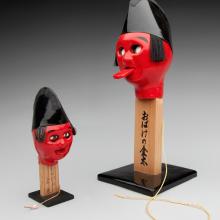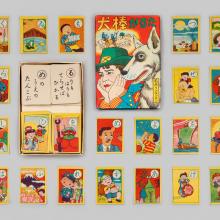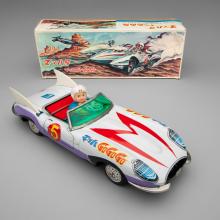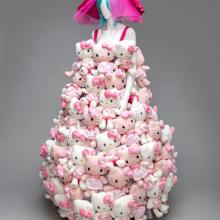Terminal 3










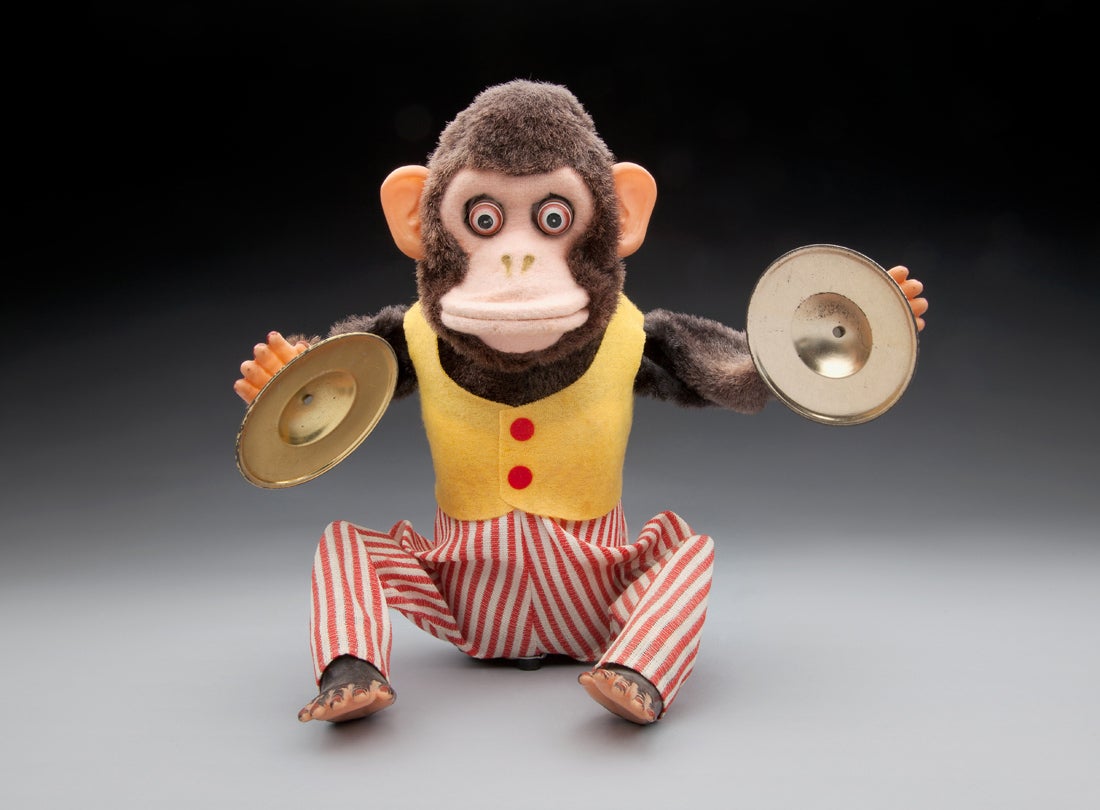


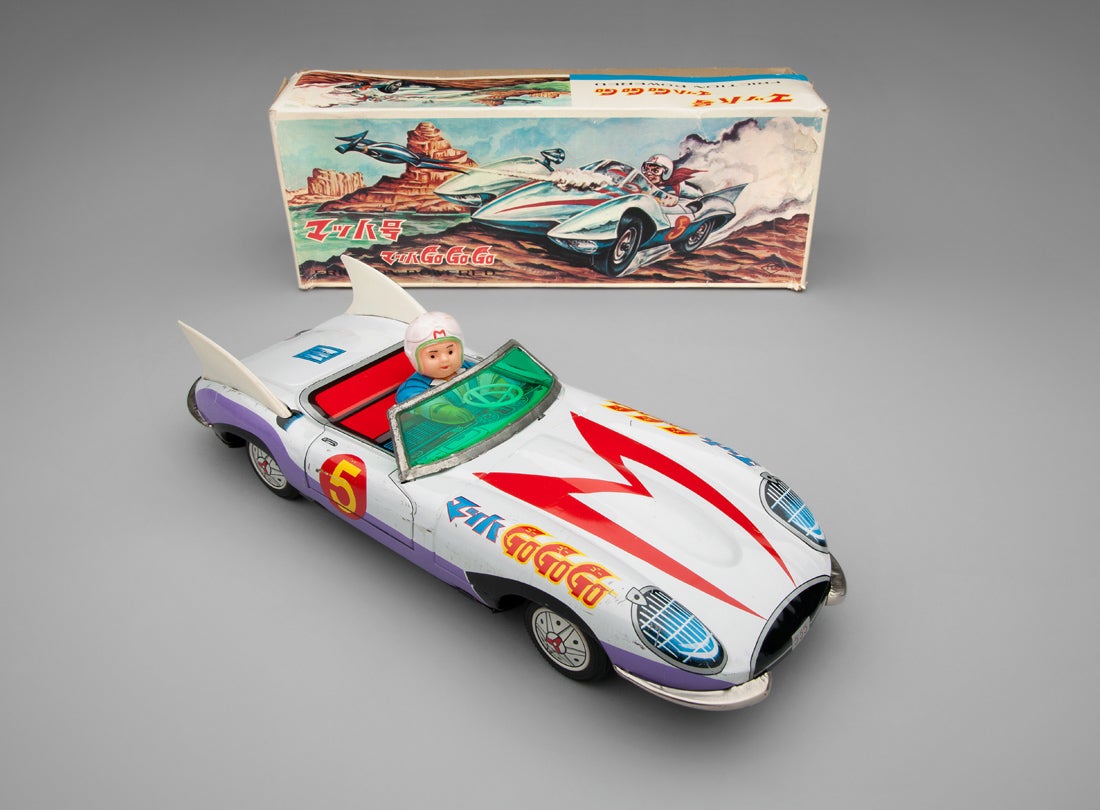
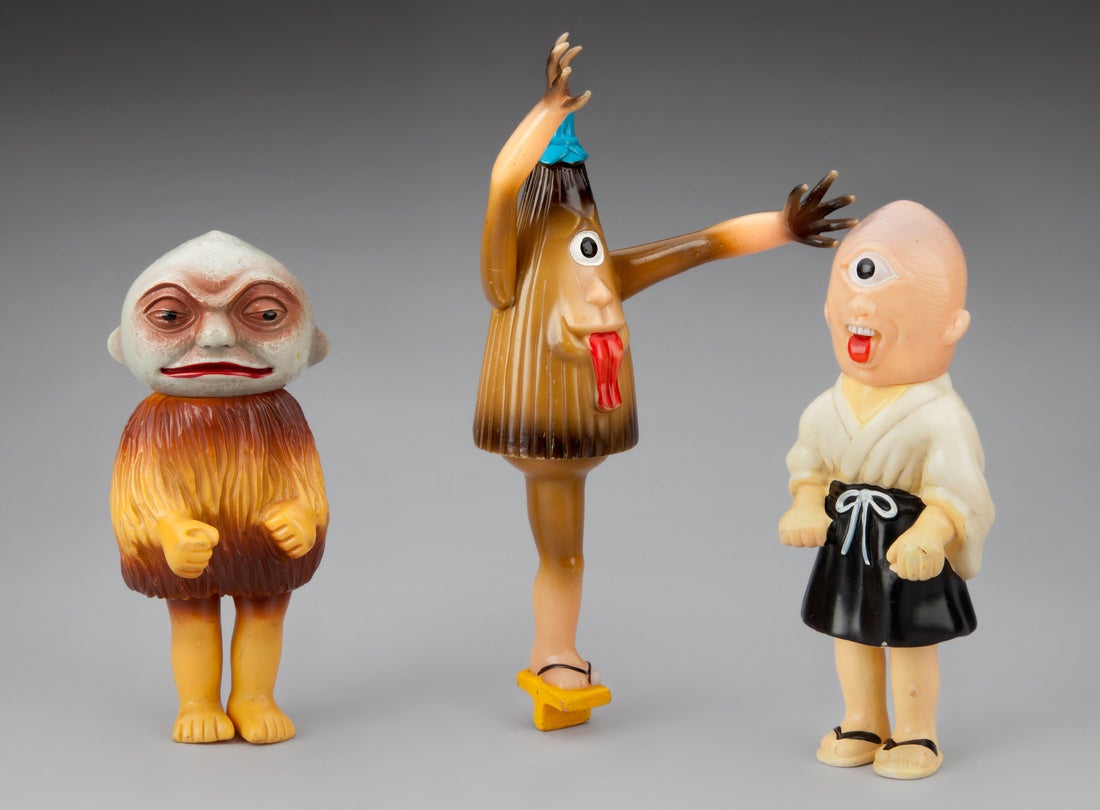
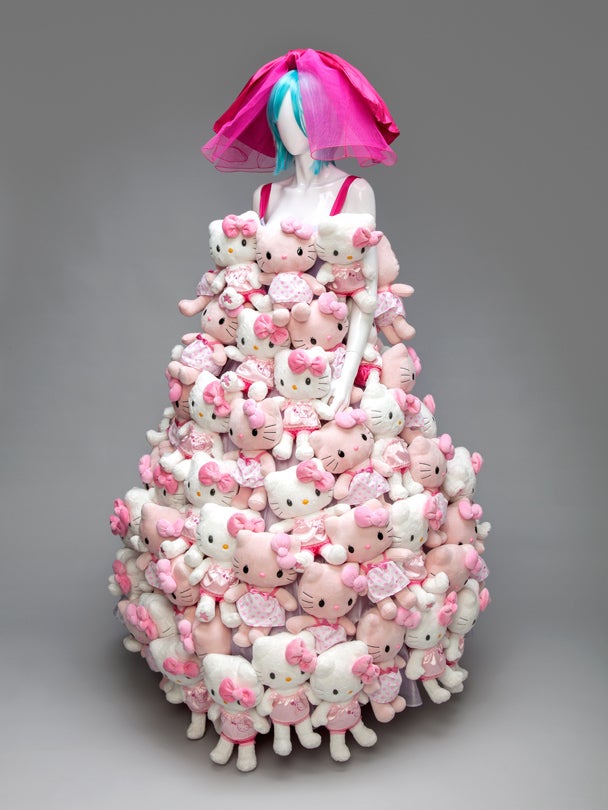
Kokeshi dolls 20th century
Japan
Kadota Collection, California Academy of Sciences and Anonymous lender
CAS 1993-0010-0007, -0003
L2013.1501.025, .029, L2013.1504.036, .040, .044
Kokeshi, probably the most beloved folk dolls in Japan, stem from a tradition that dates at least to the 1800s. Craftsmen first made kokeshi in the northern region of Tohoku during the cold winter months. Kokeshi dolls are characterized by their lack of arms and legs and the brightly painted floral or geometrical designs on their cylindrical bodies. The process for making these rounded, wooden dolls is similar to the lathe-turning method employed to make legs for chairs or tables. These dolls served as simple toys for children and were also purchased at hot springs as souvenirs. Over time, the popularity of these figures spread and craftsmen in other regions began to make the dolls. Each area developed its own unique decorative traits allowing one to distinguish a doll’s region of origin.
During the 1920s, adults began to take an interest in collecting these dolls. Kokeshi, typically made in five-, seven-, and ten-inch sizes were now made from miniature to oversized. Forms also gradually changed. Dento or traditional kokeshi were made alongside sosaku or non-traditional dolls. The latter are easy to identify because they boldly deviate from the dento forms by displaying features such as rotund bodies or modern paint schemes.
(left to right)
Dog with basket on head c. 1955
Nihonbashi, Tokyo Prefecture, Japan
CAS 1993-0001-0332
L2013.1501.070
Dog c. 1975
Asakusa, Tokyo Prefecture, Japan
CAS 1993-0001-0394
L2013.1501.077
Colorful, mythical Japanese characters have traditionally appeared in the form of papier-mâché, a centuries-old craft technique in Japan. Guardian dogs are among some of the most popular papier-mâché figurines. Some playful dog figurines have baskets on their heads. Such dogs often serve as guardians, which are hung over babies’ beds to watch over them. Other dog figurines with small drums attached to their backs are presented to babies when they make their first trip to the family shrine.
Many legendary stories about guardian dogs developed during the Edo period (1615–1868) in Japan. One story tells the tale of Kobo Daishi (774–835), a Buddhist monk who spent the night at a local farmer’s home during a pilgrimage. This courteous farmer told Daishi that he was troubled by boars in his fields and asked him for a protective amulet. Kobo Daishi allegedly created a paper-dog charm, which he folded, sealed, and gave to the farmer to hang in his fields to protect his crops. When the farmer, curious about the highly effective amulet, eventually opened it, the paper dog flew away.
Animated toy soldiers (Kinta) c. 1985
Kumamoto, Kumamoto Prefecture, Japan
Kadota Collection, California Academy of Sciences
CAS 1993-0001-0212, -0227
L2013.1501.060, .061
Imaginative Japanese toy makers and artisans created a vast range of unusual toys. Based on an actual person, one of these oddities includes the red-faced Kinta, a soldier and heavy drinker who served under the daimyō Katō Kiyomasa (1561–1611). Kinta was popular among Kiyomasa’s soldiers due to his sense of humor and penchant for playing practical jokes. He wears a black military hat; his head is mounted on a wooden pole that is attached to a string. When one pulls the string, Kinta appears ghoulish: his eyes roll and his tongue sticks out. During the late Edo period, a doll maker in Kumamoto allegedly created the first Kinta figure based on the legend of the soldier.
Hagoita paddles c. 1920s–30s
Japan
Anonymous lender
L2013.1504.061, .062
Hanetsuki is a traditional Japanese New Year’s game played since the seventeenth century with a wooden paddle called hagoita. The game resembles badminton played without a net. While the game’s popularity has declined in recent times, beautifully ornamented hagoita are still a popular collector’s and decorative item. They are painted or decorated with fabric collage, then sold at shrines and fairs in December.
Wind-up rancher and wind-up Indian rider on horse 1930s
Japan
Anonymous lender
L2013.1504.005.01-.02,.006.01-.02
Beginning in the early twentieth century, Japanese manufacturers made toys from celluloid, a semi-synthetic plastic. Camphor, a key component in the manufacturer of celluloid was easily obtained from Taiwan, an island heavily forested with camphor trees. Hollow, blow-molded, celluloid figural dolls and characters, toy animals, rattles, and wind-up toys replaced traditional materials such as ceramic and wood.
Battery-operated man on motorcycle 1950s
Masudaya/Modern Toys
Japan
SFO Museum
1998.055.003
L2013.1510.010.01-.02a,b
Japanese toys makers began to produce tinplate toys for export around 1914, modeling the first of these after their German counterparts. Soon, the Japanese seized a large portion of the global toy industry when German toy manufacturers ceased production during World War I. Anti-German sentiment in the United States following the war and Japanese manufacturers highly sophisticated tin printing and punching machines further helped to increase sales. Many early Japanese tin toys were made by rejected tin produced by canning plants, which is why the interiors of some toys are printed with tuna or powdered-milk labels. By the 1920s and 1930s, Japanese tinplate toys quickly earned a worldwide reputation for their quality and detailed workmanship. Many toys were powered by wind-up or friction driven mechanisms, and later, by batteries.
Box of Rin Tin Tin karuta cards c. 1950s
Japan
Collection of Reed Darmon
L2013.1508.013a,b
Karuta cards, derived from the Portuguese word for card, were used to play a traditional card game. In one version of this game, a person reads out a poem or well-known proverb, and the player who most quickly identifies the card with the corresponding picture or character wins the card.
Astro Boy telephone 1980
Yonezawa
Japan
Courtesy of Kimono My House
L2013.1511.009.01-.02
In 1952, Osamu Tezuka (1928–89), the “father of manga” (Japanese comics), introduced Testuwan Atomu or Mighty Atom, his best-known work. Referred to as Astro Boy outside of Japan, this manga set the stage for modern Japanese manga, anime, and character merchandising. In 1963, Mighty Atom became the first black-and-white animated television series in Japan. The same year, Astro Boy appeared on television in the United States. Despite Astro Boy’s onscreen success, Tezuka continued to pen the manga-version for another twenty years. In 1982, a new color version of the animated series was produced.
Set in 2003, Astro Boy tells the story of a little robot boy invented by the brilliant Dr. Tenma to serve as a substitute for his son who tragically dies in a car accident. When Astro Boy’s “father” realizes that he will never grow up, he sells him to the circus. Not long after, the kind Professor Ochanomizu begins to care for Astro Boy. From this time on, Astro Boy does his best to protect the world from a variety of monsters, criminals, and evil robots using his special powers. Jets in his arms and feet allow Astro Boy to fly, and he can use his eyes as searchlights. He speaks sixty languages, has the ability to amplify his hearing one thousand times, and can detect whether a human being has good or bad intentions. Astro Boy also has machine guns in his bottom (though this was downplayed in the American version). This defender of peace and justice has a computer for a brain and a 100,000-horse-power atomic reactor in his chest.
(clockwise)
Blinking Godzilla lamp 1982
Japan
Anonymous lender
L2013.1512.004
Hedorah figure from Godzilla vs. Hedorah 1971
Bullmark
Japan
Anonymous lender
L2013.1512.007
King Ghidorah figure (Hawaiian version) from Ghidorah, the Three-Headed Monster 1975
Bullmark
Japan
King Rory Collection
L2013.1503.044
Godzilla launched the monster or kaiju genre of live-action tokusatsu films in Japan. A prehistoric creature spawned from nuclear radiation, Godzilla stood thirty-stories tall, breathed radioactive fire, and had thick, scaly skin that proved useless against regular weapons. Gojira, the monster’s Japanese name, combined the Japanese words for gorilla and whale, though the creature more closely resembled a fearsome dinosaur. The nuclear bombings in Hiroshima and Nagasaki, the atomic tests at Bikini Atoll in the Marshall Islands, and American films such as King Kong (1933) influenced the making of the film. Godzilla, released by Toho, the premiere kaiju film company in Japan, was the most expensive Japanese cinematic production at the time. It cost over 100 million yen to make or about 1.5 million dollars in 1954. Tomoyuki Tanaka (1910–97) was the film producer responsible for the creation of Godzilla. Eiji Tsuburaya (1901–70) served as the visual effects mastermind, while Ishiro Honda (1911–93) directed the film. Actors Haruo Nakajima (b. 1929) and Katsumi Tezuka (b. 1912), played the excruciating role of Godzilla, sharing the task of wearing a 220-pound rubber suit.
The first film enjoyed tremendous success in Japan as well as the United States when it appeared in cinemas in 1956 as Godzilla, King of the Monsters. In the American version, added scenes of American actor Raymond Burr, who played the role of narrator and foreign correspondent, were spliced into the film. Godzilla’s Counterattack (1955), the second feature, became the first in a long line of films where Godzilla became the kaiju-hero everyone rooted for as he battled against a variety of menacing monsters, including Mothra, a giant moth. Despite Godzilla’s popularity, Godzilla toys did not become readily available until the 1960s.
Battery-operated Mr. Robot 1960
Cragstan-Yonezawa
Japan
Collection of Mark Nagata
L2013.1502.064
The word robot was first used by the Czech author Karel Capek in reference to artificial people in 1921. It originated from the Czech word robata meaning work or labor. Although the science of robotics only came about in the twentieth century, the history of human-invented automation has a much lengthier past. Japanese craftsmen Hisashige Tanaka (1799–1881) made many early mechanical creations. Among these toys were figures that could serve tea, shoot arrows, and write. In Japanese culture,robots are often portrayed as beloved companions that pose no threat, even when given human emotions and free will.
The first tin toy robot was most likely Lilliput, made in Japan in 1938. By the mid-1950s, Japanese manufacturers made a variety of collectible tin toy robots, known as mecha. Determined to surpass America and Germany in the toy market, Japanese toy makers worked on perfecting toy robots by imparting them with unique actions and attractive lithography. Soon, they incorporated battery-powered features like spinningwheels.
Battery-operated cymbal-clapping monkey c. 1950s–60s
Japan
Anonymous lender
L2013.1504.084
After World War II, the Japanese were the first toy makers to replace wind-up clockwork mechanisms and friction-driven mechanical toys with mini-electric motors powered by one or more batteries. Small electric motors could run much longer than wind-up or friction-driven mechanisms. Batteries were used previously in toys, but usually only for lights or noise. Toy makers designed a multitude of remarkable novelties—from robots to washing bears. These battery-operated toys were able to simulate all sorts of human and animal motions. Battery-operated toys peaked from the mid-1940s to 1960s when many quality Japanese toy companies were established. Around this time, nearly ninety percent of battery-operated toys were produced in Japan, most of which were destined for Western markets. Many American manufactures, such as Marx, found it more cost effective to market these Japanese-made toys under their brand name rather than manufacture their own in the United States.
Ultraman and Alien Baltan figures 1966–67
Bullmark/ Marusan
Japan
Collection of Mark Nagata
L2013.1502.003
In the television series Ultraman, malevolent aliens and giant monsters constantly threaten civilization. The only Earth organization equipped to handle these disasters is the Science Patrol, a special worldwide police force equipped with high-tech weapons, vehicles, and extensive scientific facilities. After an accident leaves the Science Patrol member Hayata dead, Ultraman, an alien from the exploded planet Nebula M78, merges with him in order to bring Hayata back to life. When the Science Patrol fails to defeat the monsters and aliens that regularly threaten Japan, Hayata secretly transforms into Ultraman, saving the day before speeding off and reverting back to his human self. Ultraman has a beta capsule or flash beam that provides him with power for a short period of time and allows his transformation. A color timer, or warning light, located on his chest, flashes from blue to red when his tremendous powers, drawn from the beta capsule’s solar rays, begin to diminish. Ultraman has many super powers; he flies, shoots spacium rays to ward off his attackers when his wrists are crossed, and fires halo-like rings from his hand that can slice his opponents in half. Despite his special powers, many of his battles with various kaiju typically involve a fair bit of old-fashioned wrestling.
Red King figure 1967
Bullmark
Japan
Collection of Mark Nagata
L2013.1502.019
King Zaurus Red King salesman’s prop probably 1976
Popy
Japan
King Rory Collection
L2013.1503.028
Introduced in 1966 the television series Ultraman featured a cornucopia of colorful kaiju or monsters that became as iconic and beloved as the superhero. Production designer Tohru Narita (1929–2002) brought each monster to life. Narita occasionally deviated from the original descriptions of the monsters because the scriptwriters often neglected to describe the monster’s physical characteristics. Other times, no name was given to the featured kaiju. If this occurred, staff decided on a name during general meetings. When staff determined whether a writer conceptualized a monster beyond the means of 1960s visual effects technology, Narita had free reign to design something more practical. Many anonymous actors played these curious kaiju under difficult conditions. Actors crammed into nearly suffocating latex and foam suits, traversed toxic glue and oil fires, withstood incendiary projectiles, and confronted the superhero in deadly battles. A variety of monsters also appeared in the spinoff series that followed Ultraman.
Red King made two appearances in the Ultraman series. He can easily tear limbs off of others monsters and is strong enough to lift large hill-size boulders. The monster was discovered on a remote island with other monsters where they terrorized a small group of scientists.
Friction-driven Mach 5 car with Speed Racer 1967
Japan
Collection of Boss Robot Hobby, Berkeley, CA
L2013.1506.003.01-.02
In 1966, Tatsuo Yoshida (1932–77) published the car-racing manga Mach Go Go Go. Yoshida, who was influenced by American culture at the time of its creation, depicted the characters with a westernized appearance. The series was actually based on Yoshida’s earlier manga Pilot Ace. Mach Go Go Go appeared on Japanese television as a series in 1967. The trend at the time was to create a successful manga first and then promote the animated television series adaptation. Gô Mifune, the show’s teenage star, aspires to be the world’s best racecar champion with the help of his friends, family, and his father’s high-tech racecar. His first name Gô, represents a Japanese homophone for the number five on his car and the English word go.
In 1967, Mach Go Go Go was syndicated for television in the United States. Speed Racer replaced Gô Mifune as the lead character’s name and the series was titled Speed Racer. Although Speed Racer did not have the same technical quality as many American cartoons, its cast of characters, morality-themed episodes, complex plots, sound effects, and unique camera angles, were far removed from American cartoons such as the Flintstones, which aired around the same time.
Yōkai monster figures 1968
Nitto
Japan
King Rory Collection
L2013.1503.023, .024, .025
Long before kaiju, Japan had a long tradition of yōkai or supernatural ghouls, some imported from China, others spawned directly from local lore and superstition. Yōkai lurked in the mountains, forests, and fields of Japan, and are depicted in folktales, woodblock prints, and paintings. During the 1960s, the Daiei Motion Picture Company also produced a series of tokusatsu films featuring yōkai monsters. Today, they even make appearances in video games, manga, and popular toys.
Hello Kitty plush dress 2013
Sanrio, Inc.
South San Francisco
Courtesy of Sanrio, Inc.
L2013.1509.015.01-.04
SANRIO was founded in Japan in the 1960s by Shintaro Tsuji, whose simple dream of bringing smiles to people’s faces, grew into the brand’s “small gift, big smile” philosophy. This concept inspired a broad spectrum of items bearing the likeness of the legendary global icon, Hello Kitty. The global icon first appeared on a small coin purse in 1974, and now graces an extraordinary number of items including stationery, toys, electronics, cosmetics, apparel, and accessories. Hello Kitty permeates pop culture, from art to fashion and celebrity. She celebrates her 40th anniversary in 2014.
Hello Kitty was created with a full family history. Her official name is Kitty White, and her birthday is on November 1st. She lives in London with her parents and her twin sister Mimmy. She always wears her trademark bow over her left ear. Her sister Mimmy wears a yellow bow over her right ear so everyone can tell them apart. Hello Kitty is as tall as five apples and weighs about three apples. Her hobbies include traveling, listening to music, reading, eating yummy cookies, and best of all, making new friends, because as Hello Kitty always says, “You can never have too many friends!”


